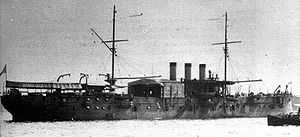Seaplane tender

A seaplane tender (or seaplane carrier) is a ship that provides facilities for operating seaplanes. These ships were the first aircraft carriers and appeared just before the First World War.
History
.jpg)
The first seaplane tender appeared in 1911 with the French Navy La Foudre, following the invention of the seaplane in 1910 with the French Le Canard. La Foudre carried float-equipped planes under hangars on the main deck, from where they were lowered on the sea with a crane. La Foudre was further modified in November 1913 with a 10 m (32 ft 10 in)-long flat deck to launch her seaplanes.[1] Another early seaplane carrier was HMS Hermes, an old cruiser converted and commissioned with a flying-off deck in mid-1913. However, the HMS Ark Royal was the first ship in history designed and built as a seaplane carrier in 1914.
World War I

In the Battle of Tsingtao, from 5 September 1914, the Imperial Japanese Navy seaplane carrier Wakamiya conducted the world′s first naval-launched air raids[2] from Kiaochow Bay.[3] The four Maurice Farman seaplanes bombarded German-held land targets (communication centers and command centers) and damaged a German minelayer in the Tsingtao peninsula from September to 6 November 1914, when the Germans surrendered.[4]
On Christmas Day 1914, the British carried out the Cuxhaven Raid; seaplanes carried within range of their targets attacked German naval targets in the Heligoland Bight.
These carriers had hangars for storing and maintaining the aircraft, but no flight deck as in a true aircraft carrier. Instead, they used cranes to lower the aircraft into the sea for takeoff and to recover them after landing. The ships were normally converted merchant vessels rather than specially constructed for the task. As aircraft improved the problems of using seaplanes became more of a handicap. The aircraft could only be operated in a smooth sea and the ship had to stop for launching or recovery, both of which took around 20 minutes. The tender was often stationed 10 mi (8.7 nmi; 16 km) or so in front of the main battle fleet with the cruiser screen so that it would not fall hopelessly behind when it launched its aircraft. Seaplanes also had poorer performance than other aircraft because of the drag and weight of the floats. Seaplane tenders had largely been superseded by aircraft carriers in the battle fleet by the end of the First World War, although aircraft were still of minor importance compared to the firepower of naval artillery.
The British HMS Ark Royal was a seaplane tender with a flying-off deck. Seaplanes could be recovered while the ship was under way through the "Hein Mat" — a sheet towed behind the vessel, once the aircraft was on the mat it was effectively stationary with respect to the ship and could be hoisted aboard..jpg)
In the inter-war years, it was common for cruisers and battleships to be equipped with catapult-launched reconnaissance seaplanes. A few navies—especially those without true aircraft carriers—also acquired catapult-equipped seaplane carriers for fleet reconnaissance.
World War II
.jpg)
During the Second World War, both the American and the Japanese Navies built a number of seaplane tenders to supplement their aircraft carrier fleets. However, these ships often had their catapults removed, and were used as support vessels that operated seaplanes from harbours rather than in a seaway. These aircraft were generally for long range reconnaissance patrols. The tenders allowed the aircraft to be rapidly deployed to new bases because their runways did not have to be constructed, and support facilities were mobile much like supply ships for submarines or destroyers.
The German Navy in World War II did not operate any seaplane tenders. However, the German Air Force, the Luftwaffe, had nineteen seaplane tenders. These ships were mostly converted from existing civilian seaplane tenders, and were capable of carrying 1-3 seaplanes. The French and Italian Navies also had seaplane tenders.
Seaplane tenders became obsolete at the end of the Second World War. A few remained in service after the war but by the late-1950s most had been scrapped or converted to other uses such as helicopter repair ships.
List of examples
Examples of seaplane tenders included:
- HMAS Albatross (Australia, 1928)
- Akitsushima Maru (Japan, served from 1942 until sunken in 1944)
- La Foudre (France, converted into the world′s first seaplane tender in 1911-13)
- Chitose (Japan, 1936; she and sister ship Chiyoda converted to conventional aircraft carriers in 1943-1944)
- Commandant Teste (France, 1932)
- Giuseppe Miraglia (Italy, converted from merchant vessel Citta de Messina in 1927)
- Dédalo (Spain, converted from German merchant vessel Neuenfels in 1922)
- HMS Ark Royal (UK, 1914, renamed Pegasus in 1934)
- HMS Ben-my-Chree (UK, a ferry converted in 1915 used in WWI)
- HMS Engadine (UK, 1911, another converted ferry; present at the Battle of Jutland)
- HMS Campania (UK)
- HMS Riviera (UK, sister ship of Engadine)
- USS Langley (USA′s first aircraft carrier; converted into a seaplane tender in 1937)
- USS Mississippi (USA, an obsolete battleship used as a seaplane tender in 1914)
- USS Curtiss (USA WWII Pearl Harbor to Okinawa)
- USS Currituck and USS Pine Island (USA WWII-era seaplane tenders, both later participated in Operation Highjump, a 1947 mission to Antarctica)
- USS Norton Sound (Began service as Currituck-class seaplane tender AV-11, later converted to AVM-1 - first US guided-missile ship)
- USS Tangier (USA, a cargo ship converted to a seaplane tender during World War II)
- USS Timbalier (tended Martin PBM Mariner flying boats until 1954)
See also
![]() Media related to Seaplane tenders at Wikimedia Commons
Media related to Seaplane tenders at Wikimedia Commons
- Seaplane bases in the United Kingdom
Notes
- ↑ Description of Foudre
- ↑ Wakamiya is "credited with conducting the first successful carrier air raid in history"Source:GlobalSecurity.org
- ↑ "Sabre et pinceau", Christian Polak, p92
- ↑ IJN Wakamiya Aircraft Carrier
| |||||||||||||||||||||||||||||||||||